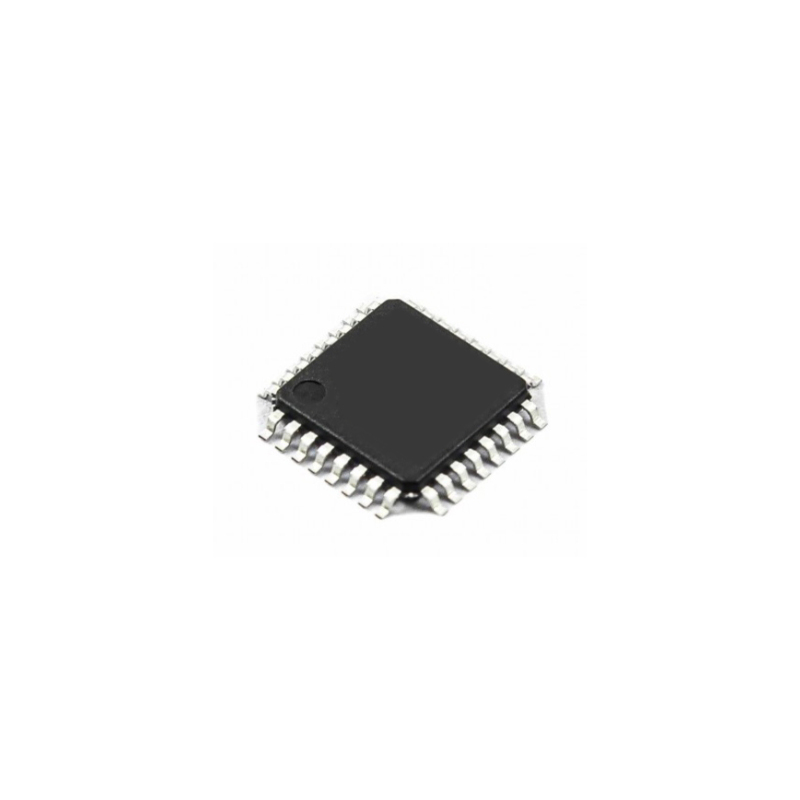The AT89C51ED2-RLTUM emerges as a powerhouse within the realm of 8051 architecture, boasting high-performance capabilities tailored for a myriad of embedded system applications. Equipped with a robust 64-kilobyte Flash memory block and a suite of integrated peripherals, this CMOS Flash microcontroller offers developers a versatile platform for realizing their innovative designs. From industrial automation to smart metering systems, the AT89C51ED2-RLTUM serves as a reliable and efficient solution, driving advancements across diverse sectors with its rich feature set and flexible programming options.
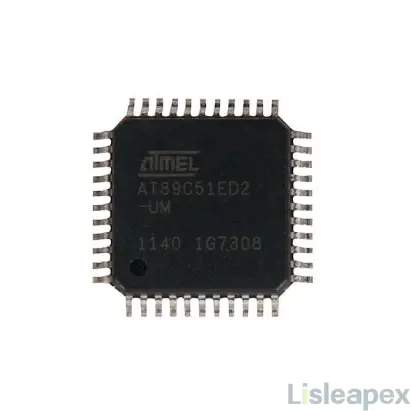
What is AT89C51ED2-RLTUM
The AT89C51ED2-RLTUM stands out as a high-performance CMOS Flash microcontroller within the 8051 architecture domain. Featuring a robust 64-kilobyte Flash memory block dedicated to both code and data storage, it provides ample space for firmware development and data retention. This microcontroller offers versatility in programming, supporting both parallel and serial modes, including In-System Programming (ISP) capability, which facilitates convenient firmware updates without requiring physical chip removal. It inherits essential features from the Atmel 80C52, including 256 bytes of internal RAM, a 9-source 4-level interrupt controller, and three timer/counters, ensuring compatibility with existing 8051-based applications while offering room for expansion.
Moreover, the AT89C51ED2 variant enhances its utility with 2048 bytes of EEPROM, enabling nonvolatile data storage for critical application parameters and configurations. Additionally, it integrates advanced features such as a Programmable Counter Array, 1792 bytes of XRAM, and a Hardware Watchdog Timer, enhancing its suitability for a wide array of embedded system applications. The microcontroller further enriches its connectivity options with interfaces like SPI and UART, facilitating seamless communication with external devices and peripherals.
Noteworthy is its fully static design, allowing for dynamic clock frequency adjustments to optimize power consumption based on application requirements. With support for Idle and Power-down modes, the AT89C51ED2-RLTUM ensures efficient utilization of system resources while preserving peripheral functionality, making it an energy-efficient choice for battery-powered and power-sensitive applications. Ideal for tasks demanding pulse width modulation, high-speed I/O operations, and precise counting capabilities, this microcontroller finds widespread use across industrial automation, consumer electronics, automotive systems, and beyond.
AT89C51ED2-RLTUM Pinout
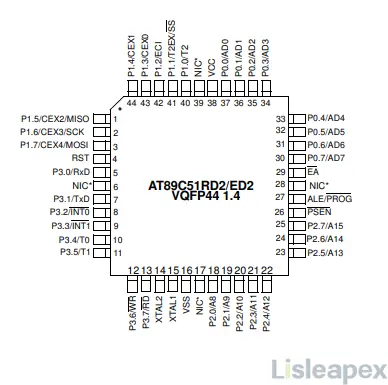
Pin Description for VQFP44 package,
|
Mnemonic |
Pin Number |
Type |
Name and Function |
|
VSS |
16 |
I |
Ground: 0V reference |
|
VCC |
38 |
I |
Power Supply: This is the power supply voltage for normal, idle and power-down operation |
|
P0.0 - P0.7 |
37 - 30 |
I/O |
Port 0: Port 0 is an open-drain, bidirectional I/O port... |
|
P1.0 - P1.7 |
40 - 44 |
I/O |
Port 1: Port 1 is an 8-bit bidirectional I/O port with internal pull-ups... |
|
XTALA1 |
15 |
I |
XTALA 1: Input to the inverting oscillator amplifier and input to the internal clock generator circuits |
|
XTALA2 |
14 |
O |
XTALA 2: Output from the inverting oscillator amplifier |
|
P2.0 - P2.7 |
18 - 25 |
I/O |
Port 2: Port 2 is an 8-bit bidirectional I/O port with internal pull-ups... |
|
P3.0 - P3.7 |
7 - 13 |
I/O |
Port 3: Port 3 is an 8-bit bidirectional I/O port with internal pull-ups... |
|
P4.0 - P4.7 |
24 - 44 |
I/O |
Port 4: Port 4 is an 8-bit bidirectional I/O port with internal pull-ups... |
|
P5.0 - P5.7 |
62 - 16 |
I/O |
Port 5: Port 5 is an 8-bit bidirectional I/O port with internal pull-ups... |
|
RST |
4 |
I |
Reset: A high on this pin for two machine cycles while the oscillator is running, resets the device... |
|
ALE/PROG |
27 |
O(I) |
Address Latch Enable/Program Pulse: Output pulse for latching the low byte of the address during an access to external memory... |
|
PSEN |
26 |
O |
Program Strobe ENable: The read strobe to external program memory... |
|
EA |
29 |
I |
External Access Enable: EA must be externally held low to enable the device to fetch code from external program memory locations 0000H to FFFFH... |
Footprint and Models
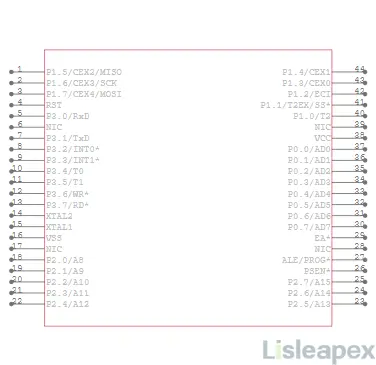
Symbol
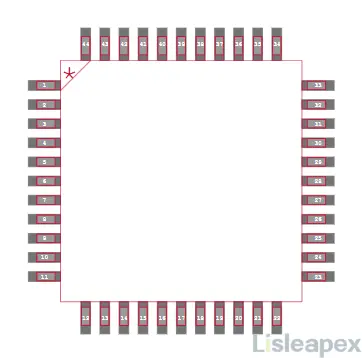
Footprint
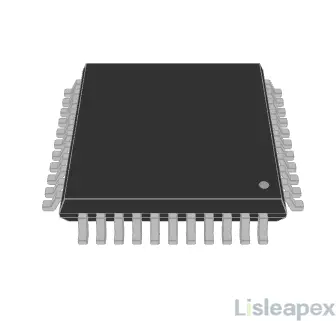
3D model
AT89C51ED2-RLTUM Specifications
|
Product Category |
8-bit Microcontrollers - MCU |
|
Core |
8051 |
|
Program Memory Size |
64 kB |
|
Data RAM Size |
2 kB |
|
Package / Case |
VQFP-44 |
|
Maximum Clock Frequency |
60 MHz |
|
ADC Resolution |
No ADC |
|
Number of I/Os |
34 I/O |
|
Supply Voltage - Min |
2.7 V |
|
Supply Voltage - Max |
5.5 V |
|
Mounting Style |
SMD/SMT |
|
Data Bus Width |
8 bit |
|
Minimum Operating Temperature |
-40°C |
|
Maximum Operating Temperature |
+85°C |
|
Height |
1.45 mm |
|
Interface Type |
SPI, UART |
|
Length |
10.1 mm |
|
Moisture Sensitive |
Yes |
|
Number of Timers/Counters |
3 Timer |
|
Width |
10.1 mm |
|
Unit Weight |
0.068149 oz |
Features of AT89C51ED2-RLTUM
- 8051 Core: Incorporates the classic 8051 architecture, ensuring a stable and reliable microcontroller core.
- Large Memory Capacity: Features 64 kB of program memory and 2 kB of data RAM, suitable for storing extensive programs and data.
- High Clock Frequency: Operates at a maximum clock frequency of 60 MHz, enabling efficient instruction execution and rapid task processing.
- Abundant I/O Interfaces: Provides 34 I/O pins, facilitating connections to external devices and peripherals to meet diverse application needs.
- Wide Voltage Range: Supports a supply voltage range from 2.7 V to 5.5 V, allowing for flexible power supply configurations.
- Compact Package: Housed in a VQFP-44 package, suitable for surface-mount installation, facilitating integration into various electronic systems.
- Versatile Interfaces: Supports SPI and UART interfaces, enhancing communication capabilities and enabling interaction with a variety of external devices.
- Wide Operating Temperature Range: Operates reliably across a broad temperature range from -40°C to +85°C, suitable for deployment in diverse environmental conditions.
Special Function Registers(SFR) Mapping
The Special Function Registers (SFRs) of the AT89C51RD2/ED2 microcontroller are categorized as follows:
- C51 core registers: ACC, B, DPH, DPL, PSW, SP
- I/O port registers: P0, P1, P2, P3, PI2
- Timer registers: T2CON, T2MOD, TCON, TH0, TH1, TH2, TMOD, TL0, TL1, TL2, RCAP2L, RCAP2H
- Serial I/O port registers: SADDR, SADEN, SBUF, SCON
- PCA (Programmable Counter Array) registers: CCON, CCAPMx, CL, CH, CCAPxH, CCAPxL (x: 0 to 4)
- Power and clock control registers: PCON
- Hardware Watchdog Timer registers: WDTRST, WDTPRG
- Interrupt system registers: IE0, IPL0, IPH0, IE1, IPL1, IPH1
- Keyboard Interface registers: KBE, KBF, KBLS
- SPI registers: SPCON, SPSTR, SPDAT
- BRG (Baud Rate Generator) registers: BRL, BDRCON
- Clock Prescaler register: CKRL
- Others: AUXR, AUXR1, CKCON0, CKCON1
All SFRs with the address and their reset value,
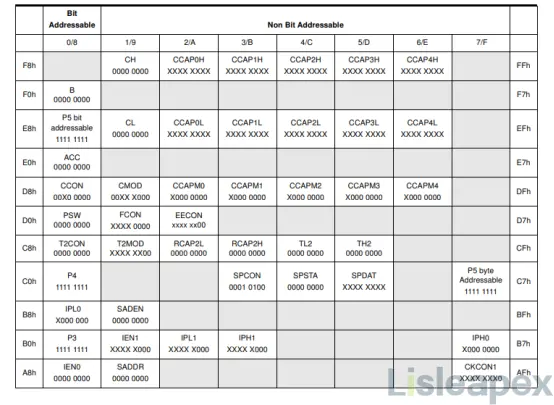
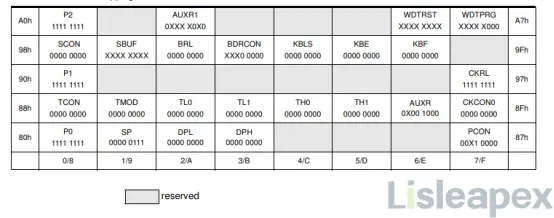
AT89C51ED2-RLTUM Application & Uses
Home Automation System:
The AT89C51ED2-RLTUM can serve as the brain of a home automation system, controlling various aspects such as lighting, heating, ventilation, air conditioning (HVAC), security cameras, and door locks. It can interface with sensors to detect motion, temperature, and light levels, allowing for automated adjustments based on predefined settings or user preferences. Additionally, it can facilitate remote monitoring and control via smartphone apps or web interfaces, enhancing convenience and energy efficiency in residential environments.
Industrial Process Control:
In industrial settings, the AT89C51ED2-RLTUM can be employed for process control applications, managing and optimizing manufacturing processes, conveyor systems, and production lines. It can interface with sensors to monitor parameters such as temperature, pressure, flow rate, and level, making real-time adjustments to maintain optimal operating conditions and ensure product quality. Moreover, it can facilitate data logging and analysis for process optimization and regulatory compliance.
Smart Metering System:
The microcontroller can be used in smart metering systems for measuring and monitoring utility consumption, such as electricity, gas, and water. It can interface with sensors and transducers to accurately measure consumption levels and transmit data to utility providers or consumers for billing, analysis, and conservation purposes. Additionally, it can support features like remote meter reading, tamper detection, and load management to enhance efficiency and reliability in energy management.
Vehicle Monitoring and Control:
In automotive applications, the AT89C51ED2-RLTUM can function as the control unit for vehicle monitoring and control systems. It can interface with sensors to monitor parameters such as engine performance, fuel consumption, tire pressure, and vehicle speed, providing real-time diagnostics and feedback to the driver. It can also control functions like engine management, transmission control, and vehicle stability systems to optimize performance, enhance safety, and reduce emissions.
Wireless Sensor Networks (WSNs):
The microcontroller can be used in wireless sensor networks for environmental monitoring, agriculture, and infrastructure management. It can interface with various sensors to collect data on temperature, humidity, soil moisture, air quality, and other environmental parameters. The data collected can be transmitted wirelessly to a central server for analysis and decision-making, enabling applications such as precision agriculture, environmental monitoring, and disaster management. Additionally, the microcontroller's low-power features make it suitable for battery-operated sensor nodes deployed in remote or inaccessible locations.
How to Program AT89C51ED2-RLTUM With Arduino
Programming the AT89C51ED2-RLTUM microcontroller using an Arduino requires additional hardware and a specific process due to differences in architecture and programming methods. Here's a general guide on how to program the AT89C51ED2-RLTUM with Arduino:
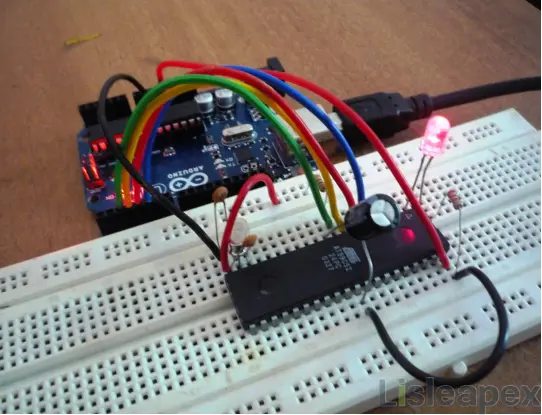
Hardware Required:
- AT89C51ED2-RLTUM microcontroller
- Arduino board (e.g., Arduino Uno)
- USB cable for Arduino board
- Breadboard and jumper wires
- External crystal oscillator (if not using the Arduino board's crystal)
Software Required:
- Arduino IDE
- AT89C51ED2-RLTUM core files for Arduino (if available)
Steps:
Setup Hardware Connections:
Connect the AT89C51ED2-RLTUM to the Arduino board using jumper wires:
Connect the VCC pin of the AT89C51ED2-RLTUM to the 5V pin of the Arduino.
Connect the GND pin of the AT89C51ED2-RLTUM to the GND pin of the Arduino.
Connect the crystal oscillator (X1 and X2 pins) of the AT89C51ED2-RLTUM to the corresponding pins on the Arduino board if an external crystal is used.
Connect the AT89C51ED2-RLTUM's reset pin (RST) to a digital pin on the Arduino (e.g., pin 10).
Install AT89C51ED2-RLTUM Core for Arduino (if available):
If there's a specific core for the AT89C51ED2-RLTUM available for Arduino, install it in the Arduino IDE following the provided instructions. This core may include necessary libraries and definitions to program the microcontroller.
Write Firmware Code:
Write your firmware code for the AT89C51ED2-RLTUM using the Arduino IDE. Ensure that you include any necessary libraries and configure the code to work with the AT89C51ED2-RLTUM's architecture.
Compile and Upload Code:
Compile the firmware code in the Arduino IDE, ensuring that the correct board (Arduino Uno or similar) is selected in the Tools menu.
Upload the compiled code to the Arduino board.
Enable Programming Mode on AT89C51ED2-RLTUM:
Before uploading the code, ensure that the AT89C51ED2-RLTUM is in programming mode. This may involve setting specific pins to certain states or configurations, depending on the programming method used (e.g., parallel, serial).
Program the AT89C51ED2-RLTUM:
Once the Arduino board is programmed with the firmware code, initiate the programming process for the AT89C51ED2-RLTUM. This may involve using special programming software or tools compatible with the AT89C51ED2-RLTUM's programming method.
Verify Programming:
After programming, verify that the firmware code was successfully written to the AT89C51ED2-RLTUM microcontroller. Test the functionality of the microcontroller in your target application environment to ensure proper operation.
Block Diagram
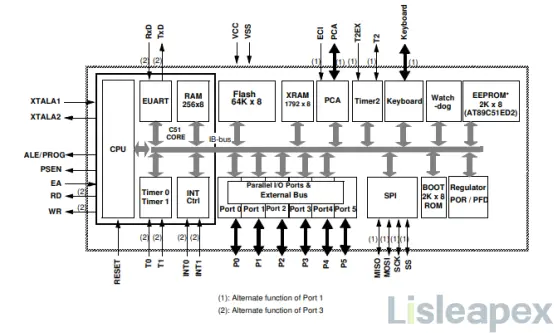
Port Types of AT89C51ED2-RLTUM
The I/O ports (P1, P2, P3, P4, P5) of the AT89C51ED2 microcontroller feature a quasi-bidirectional output design, a characteristic common among 80C51 family and its derivatives. This design enables each port to function as both an input and output without requiring reconfiguration. The quasi-bidirectional output employs three types of pull-ups for versatile functionality.
Firstly, the "weak" pull-up activates when the port latch holds a logic 1, providing a minimal current source to pull the pin high when left unconnected. Secondly, the "medium" pull-up engages when the port latch holds a logic 1 and the pin itself is at a logic 1 level, serving as the primary source current for an outputting pin set to 1. If an external device pulls a pin set to 1 low, the medium pull-up deactivates, leaving only the weak pull-up active. To pull the pin low in such a scenario, the external device must overcome the medium pull-up's current.
Lastly, the "strong" pull-up is utilized to expedite low-to-high transitions on a quasi-bidirectional port pin when the port latch shifts from logic 0 to 1. This pull-up briefly activates for two CPU clock cycles, ensuring swift elevation of the port pin voltage before deactivating again.
The DPU bit in the AUXR register grants the ability to disable the permanent weak pull-up across all ports when latch data is logical 0, offering further control over port behavior.
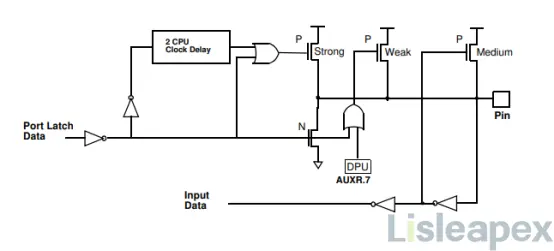
Quasi-Bidirectional Output
Functional Block Diagram
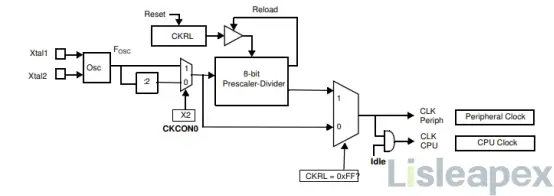
Package Dimension
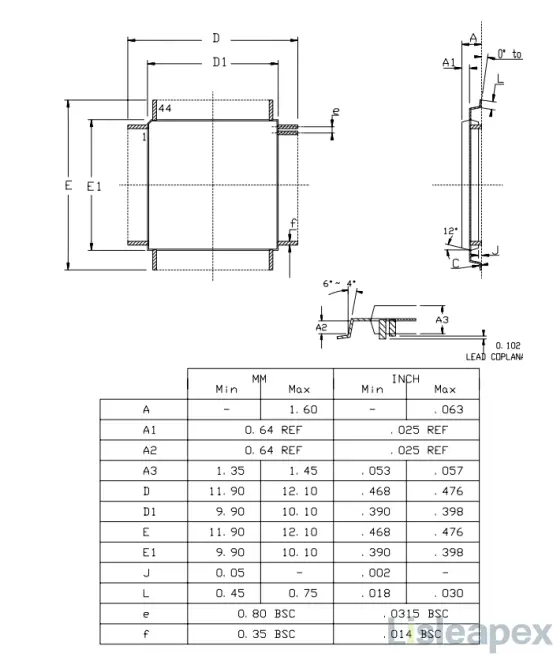
AT89C51ED2-RLTUM Datasheet PDF
Download AT89C51ED2-RLTUM datasheet PDF>>
Manufacturer
The AT89C51ED2-RLTUM microcontroller is manufactured by Microchip Technology Inc., a leading provider of microcontroller and semiconductor solutions. Microchip offers a broad portfolio of products catering to various industries, including automotive, consumer electronics, industrial, and medical sectors.
Founded in 1989 and headquartered in Chandler, Arizona, USA, Microchip has grown to become one of the largest semiconductor companies globally. With a focus on innovation, quality, and reliability, Microchip designs and manufactures a wide range of microcontrollers, analog and digital ICs, memory products, and other semiconductor devices.
Microchip's AT89C51ED2-RLTUM microcontroller is part of their extensive 8051-based product line, renowned for its robustness, versatility, and ease of use. With features such as flash memory, EEPROM, multiple I/O ports, and various communication interfaces, the AT89C51ED2-RLTUM microcontroller is well-suited for diverse embedded system applications.
Microchip's commitment to customer satisfaction, technical support, and continuous product improvement has established it as a trusted partner for engineers, designers, and developers worldwide. The company's dedication to providing high-quality semiconductor solutions, coupled with its global presence and industry expertise, reinforces its position as a leading manufacturer in the semiconductor industry.
Conclusion
In essence, the AT89C51ED2-RLTUM epitomizes the convergence of cutting-edge technology and practical utility, embodying the essence of modern embedded systems development. With its extensive memory capacity, comprehensive peripheral support, and energy-efficient design, this microcontroller empowers engineers and enthusiasts to tackle complex challenges and unlock new possibilities in the ever-evolving landscape of electronics and automation. As industries continue to embrace the era of interconnected devices and intelligent systems, the AT89C51ED2-RLTUM stands poised to catalyze innovation and drive progress toward a smarter, more interconnected future.
FAQ
-
What Voltage Levels does the AT89C51ED2-RLTUM Operate at?
The AT89C51ED2-RLTUM operates at a wide voltage range, typically from 2.7V to 5.5V. This allows it to be powered by various sources, including batteries, USB ports, and external power supplies.
-
Does the AT89C51ED2-RLTUM Have Built-in Peripherals?
Yes, it includes several built-in peripherals, including timers/counters, serial communication interfaces (UART), SPI (Serial Peripheral Interface), and I2C (Inter-Integrated Circuit) interfaces. These peripherals enhance the microcontroller's capabilities and simplify the design of embedded systems.
-
Is the AT89C51ED2-RLTUM Available in Surface Mount (SMD) Packages?
Yes, it is available in various surface mount (SMD) packages, including QFP (Quad Flat Package), TQFP (Thin Quad Flat Package), and other package types. These packages offer compact size and compatibility with modern assembly processes.
-
Can the AT89C51ED2-RLTUM Interface with External Devices?
Yes, it can interface with a wide range of external devices, sensors, displays, and communication modules using its GPIO (General-Purpose Input/Output) pins and built-in communication interfaces. This enables it to interact with the external world and control external peripherals as needed.
-
What Programming Language is Supported by the AT89C51ED2-RLTUM?
It supports assembly language programming, as well as high-level languages such as C and C++. Developers can use the Keil µVision IDE or other compatible development environments to write and debug code for this microcontroller.
Stay updated with Lisleapex by signing up for the newsletter


 Congratulations On Your Successful Submission
Congratulations On Your Successful Submission
 Submission Failure
Submission Failure
